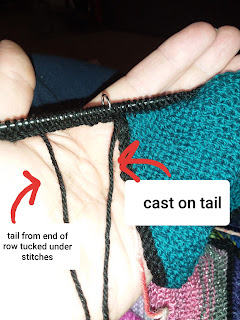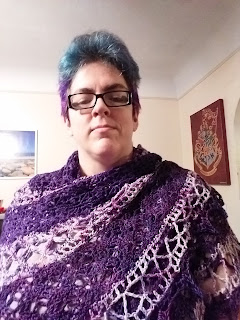I will add to this as I make it
Why am I posting a sock blanket when there are loads of sock blankets out there? I did a few tricks with this one. I'm working the co and 1st row in black which will frame each square. I'm doing a sk2p every other row and I'm slipping the last stitch for a easy pickup edge.this is also made so that all the edges are pointy and the squares are turned so points are up.
The marker is for the center decrease. It shifts on the wrong side and Mark's the decrease on the right side.
To start my blanket I made 3 square groupings so that my points at the bottom of the blanket are 2 squares deep (the top will match). My blanket is 6 points/groups wide. I made my points and then joined them once I had enough. If you dont want the deep points, just make single 1st squares and join them as described later.
PLEASE NOTE!
I am a mirror knitter. This means I knit left to right. If you are not a mirror knitter please reverse left and right! Ex. When I say join on the left, or left edge of the blanket, you will be working on your right. Photos in this pattern will appear reversed if you knit right to left.
Using fingerling/sock weight yarn and size 3 needles (I will be switching between knitting and crochet, but that will be later)
Tools:
Size 3 (3.25mm) needles
Size C (3.12mm) crochet hook
1 stitch marker
Yarn needle to weave in ends
Abbreviations
co - cast on / k - knit / pm - place marker / sm - slip marker / sk2p - slip 1, k2tog, pass slipped stitch over (double decrease) / s1wyif - slip 1 with yarn in front
sc - single crochet / ss - slip stitch / ch - chain
Always join with right side facing. Slip marker on wrong side rows, decrease on right side rows.
Casting on
At the start of a row and to make the 1st squares I use LTCO.
To co 1 I use backwards loop, knitted co works to.
To co at the end of a row I use knitted co. You can use backwards loop here as well.
1st square:
With border color: Co 24, pm, co 25 (the stitch with the marker on it will be your center stitch), Turn. - 49 stitches
*Every square will be worked exactly the same as written below after the setup row. Only the setup row varies depending on where you are placing it. The squares will give the setup row, then say finish square.
Row 1: K to marker, remove marker, k1, pm. K to end, turn. Break yarn. - 49 stitches
Join in color B:
Row 2: K to marker, sm, sk2p, k to last stitch, s1 wyif, turn - 47 stitches
Row 3: k to marker, remove marker, k1, replace marker, k to last stitch, s1 wyif, turn - 47 stitches
Repeat rows 2 and 3 till 3 stitches remain. Sk2p, k1 break yarn, pull end through and weave in ends
2nd square, Joining to square 1 on the left
With border color:
Co24, PM, co1, pickup 24 stitches along the edge, turn
-Finish square
After casting on, pickup stitches. There are 24 slipped edge stitches on the square. Start with black.
This is after the co and pickup
I leave the co tail loose so if there are any gaps or stretched stitches where it transitions from co to pickup I can use the tail to close it and straighten it up as I weave in ends. The strand on the left is my tail from breaking yarn. I've ran it under a few stitches on the needle. This shifts the tail to a place where it wont have to be weaved in where the other 2 ends are reducing bulk in that area.
Here is the square after a few rows.
3rd square, joining to square 1 on the right:
With border color and starting at the point, pickup 24 stitches from the other side of square 1, PM, co25, turn
-Finish square
4 - Joining square (also body square)
With border color, pickup 24 stitches, pm, co1, pickup 24 stitches from next square
-Finish square
All the squares in the middle will be made this way. But instead of m1, you pickup one stitch from the point of the square below as described in the next square. This can be easily done with the hook.
5 - Left inner edge including edging
*if you dont want to crochet, just pickup the 24/1/24 stitches. But doing this will leave 1 edge of the side squares without a border.
Join edging color to border edge, ch1, sc in same space, sc in next 22 edge stitches, 2 sc in last stitch, ch1, insert hook into 1st slipped edge stitch on other side of point, draw up a loop, pull loop through loop on hook and place the loop on the needle, pickup the next 23 stitches (24 stitches on needle), pm, pickup 1 stitch through the point in the middle square, pickup 24 stitches up along the edge of the next square
-Finish square
6 - Right inner edge square with edging
With border color pickup 24, pm, pickup 1 from point, pickup 24 from next square.
Leave the 49 stitches on the needle. With the hook insert it into the 1st slipped stitch on the other side of the point (outside edge), draw up a loop, ch1, sc in same space, sc in next 23 slipped stitches along the squares edge, ch1 turn.
Return row: Working in front loop only ss in each stitch to end, 1 sc into point, ch1, hook last knit stitch and pull it through the loop on the hook, place loop back on needle
- Finish square
Crochet down edge and slip back
Hook 1st stitch and pull it through the loop on hook and put it back on the needle and keep knitting
7 - outer left edge
co 24, pm, pickup 1 from point, pickup 24 stitches from side of square, turn
- Finish square
8 - outer right edge
Pickup 24 stitches along edge, PM, pickup 1 stitch from point, co 24 stitches, turn
- Finish square
End the blanket with the last row being the wide outer edge row
Finishing edging
With crochet hook, join border color to 1st border slipped stitch of last row of squares, ch1, sc in same space, 1sc in next 22 slipped stitches, 2sc in last space, [ch1, 2sc in 1st slipped stitch on other side of the point, sc in next 22 slipped stitches, insert hook into border slipped stitch, draw up a loop, (skip point), insert hook into 2st slipped border stitch of next square, draw up a loop, yo draw through 2 loops on hook. Sc in next 23 slipped stitches, 2 sc in last stitch.] Repeat to top of point on last square. Ch1, 2sc in next slipped stitch, sc in next 23 slipped stitches, break yarn and weave in ends.
This is a mockup of how I will finish it. Clearly it will not be done for a very long time, so instead of waiting till I actually finish, this is how it will be done.
Here is a picture with the squares numbered to show where they fit
You can add large squares by working the left then righ and leaving a 2 square space then picking up 2 squares worth of stitches (pickup the 48 stitches on either side).


































